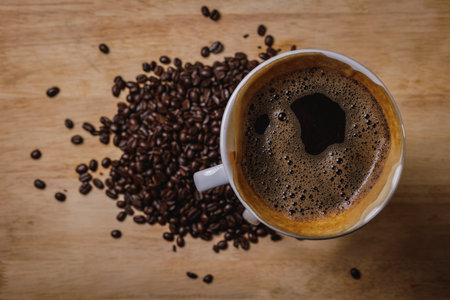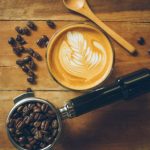Understanding What Decaf Coffee Really Is
Decaf coffee, short for decaffeinated coffee, is just like your regular cup of joe—but with most of the caffeine removed. It starts as the same coffee beans you’d find in any bag of regular coffee, but it goes through a special process to strip away the majority of its caffeine content.
What Does “Decaf” Actually Mean?
In the U.S., decaf coffee isn’t completely caffeine-free. According to guidelines set by the U.S. Food and Drug Administration (FDA), for a coffee to be labeled “decaffeinated,” it must have had at least 97% of its original caffeine content removed. That means there’s still a small amount of caffeine left in your cup, but much less compared to regular coffee.
Decaf vs. Regular Coffee: Caffeine Content Comparison
| Type of Coffee | Average Caffeine per 8 oz Cup |
|---|---|
| Regular Brewed Coffee | 95 mg |
| Decaf Coffee | 2 to 5 mg |
Why Choose Decaf?
People opt for decaf for all kinds of reasons—maybe they’re sensitive to caffeine, trying to cut back for health reasons, or just want to enjoy a warm cup of coffee later in the day without messing up their sleep. Whatever the reason, decaf gives you that familiar coffee taste without the buzz.
Key Takeaway
If you’re wondering whether decaf is truly “caffeine-free,” the answer is no—but it’s close. With only a small fraction of the caffeine left behind, decaf offers a gentler way to enjoy coffee while still staying in line with FDA standards.
2. The History and Rise of Decaf in American Coffee Culture
Decaf coffee might seem like a modern health trend, but its roots actually go back over a century. Understanding how decaffeinated coffee made its way into American culture helps explain why its still a popular choice for many coffee drinkers today.
The Origins of Decaf Coffee
Decaf coffee was first developed in the early 1900s by a German coffee merchant named Ludwig Roselius. He believed that his father died from excessive caffeine consumption, so he sought to create a coffee alternative without the stimulating effects. His process involved steaming the beans with water and using benzene—a chemical we now know is unsafe—to remove the caffeine.
Decaf Crosses the Atlantic
By the 1920s, decaffeinated coffee started to make its way into the U.S. market. Brands like Sanka (short for “sans caffeine”) introduced Americans to this new type of brew. It gained traction particularly during times when health and wellness trends were on the rise, such as the post-World War II era and again in the 1970s and 1980s.
Key Milestones in U.S. Decaf History
| Year | Event |
|---|---|
| 1905 | Ludwig Roselius develops first commercial decaf method |
| 1923 | Sanka introduced to U.S. market |
| 1950s-60s | Post-WWII health awareness boosts decaf popularity |
| 1980s | Specialty decaf options emerge with better flavor retention |
| 2000s–Present | Third-wave coffee movement offers high-quality decaf beans |
Changing Consumer Perceptions Over Time
In the early days, decaf was often seen as a compromise—something youd drink only if you had to. It was associated with older generations or people with health concerns. But today, those views are shifting. More Americans are choosing decaf not just for medical reasons, but also as part of a balanced lifestyle.
Coffee roasters now put just as much care into selecting and roasting decaf beans as they do regular ones. Thanks to improved methods like Swiss Water Process and CO₂ extraction, modern decaf can be just as flavorful as its caffeinated counterpart.
A Look at Modern Decaf Consumers
- Health-conscious individuals: Looking to reduce caffeine intake without giving up coffee.
- Coffee lovers: Wanting to enjoy a cup later in the day without losing sleep.
- Pregnant women: Choosing lower-caffeine options for safety.
- Sensitive individuals: Experiencing anxiety or jitters from regular coffee.
The rise of high-quality decaf options shows that its no longer just an afterthought—its a meaningful part of Americas evolving coffee culture.
![]()
3. How Is Caffeine Removed? Common Decaffeination Methods
If youve ever wondered how coffee becomes decaf, youre not alone. Decaffeination is a fascinating process that removes most of the caffeine from coffee beans while trying to keep the flavor intact. There are several methods used around the world, but in the U.S., three major techniques are commonly used: the Swiss Water Process, the CO2 Method, and solvent-based processes. Each has its pros and cons when it comes to safety, taste, and popularity.
Swiss Water Process
This chemical-free method is especially popular among health-conscious coffee drinkers. It uses only water, temperature, and time to remove caffeine from the beans. Heres how it works: green (unroasted) coffee beans are soaked in hot water to dissolve the caffeine. The water then passes through a special carbon filter that captures the caffeine molecules while leaving flavor compounds behind. This “flavor-charged” water is then used to decaffeinate a new batch of beans without losing much taste.
Key Points:
- Safety: 100% chemical-free
- Taste: Maintains more of the original coffee flavor
- Popularity: Gaining traction in the U.S., especially among organic brands
CO2 Method
The carbon dioxide (CO2) method is high-tech and often used for large-scale commercial decaf production. Beans are soaked in water and then exposed to compressed CO2, which selectively binds with caffeine molecules and pulls them out. This method is efficient and preserves much of the bean’s original flavor profile.
Key Points:
- Safety: Considered safe; no harmful residues
- Taste: Very good flavor retention
- Popularity: Common in mass-market decaf products
Solvent-Based Processes
This is one of the oldest and most widely used methods. It involves soaking green coffee beans in a solvent—usually either methylene chloride or ethyl acetate—that targets and removes caffeine. Afterward, the beans are steamed to remove any remaining solvent. While these chemicals might sound scary, they’re regulated by the FDA and deemed safe when used properly.
Key Points:
- Safety: FDA-approved; minimal residue remains after processing
- Taste: Can slightly alter flavor depending on method
- Popularity: Still widely used due to cost-effectiveness
Comparison Table of Decaffeination Methods
| Method | Chemicals Used? | Taste Quality | Safety Level | Popularity in U.S. |
|---|---|---|---|---|
| Swiss Water Process | No | High | Very Safe | Increasingly Popular (especially organic) |
| CO2 Method | No (uses natural CO2) | Very High | Safe | Common in mainstream brands |
| Solvent-Based Process | Yes (Methylene Chloride or Ethyl Acetate) | Moderate to Good | FDA-Approved Safe Levels | Widely Used due to Low Cost |
No matter which method is used, all decaf coffee sold in the U.S. must meet strict safety standards set by regulatory agencies like the FDA. So whether youre sipping an organic brew made with the Swiss Water Process or enjoying a budget-friendly cup using traditional solvents, you can feel confident about your choice.
4. Why People Choose Decaf: Health, Lifestyle, and Personal Preferences
Decaf coffee has become a popular choice for many Americans—not just those avoiding caffeine altogether. Whether it’s due to health concerns, daily routines, or just wanting to enjoy a cup of joe late at night without losing sleep, there are plenty of reasons people reach for decaf.
Health-Related Reasons
One of the most common motivations for choosing decaf is related to health. Some individuals experience negative side effects from caffeine, such as jitteriness, increased heart rate, or acid reflux. Others may be advised by their doctors to cut back on caffeine due to medical conditions like high blood pressure or anxiety disorders.
Common Health Reasons for Choosing Decaf
| Reason | Description |
|---|---|
| Sensitivity to Caffeine | Some people feel shaky or anxious after drinking caffeinated coffee. |
| Heart Conditions | Doctors may recommend reducing caffeine to help manage blood pressure or arrhythmias. |
| Pregnancy | Many expectant mothers limit caffeine intake during pregnancy for health reasons. |
| Acid Reflux | Caffeine can relax the esophageal sphincter, increasing reflux symptoms in some people. |
Lifestyle and Daily Routine
For others, choosing decaf is all about balance. Many coffee lovers still want the taste and warmth of their favorite beverage but without the buzz—especially in the afternoon or evening. Drinking decaf allows them to maintain their routine without disrupting sleep or overstimulating their system.
How Decaf Fits Into Everyday Life
- Afternoon Coffee Breaks: Enjoying a second cup without worrying about staying up all night.
- Evening Socializing: Sharing a warm drink with friends after dinner minus the caffeine crash.
- Mental Focus: Staying calm and steady at work without the jitters that sometimes come with regular coffee.
Personal Preferences and Taste
Some people simply prefer decaf because they enjoy the flavor of coffee but don’t need or want the energy boost. With modern decaffeination methods preserving more of the natural flavor than ever before, many can’t tell the difference between decaf and regular brews. This makes it an easy swap for those prioritizing comfort over stimulation.
A Growing Trend Among Coffee Lovers
The demand for high-quality decaf options has grown across the U.S., with specialty roasters offering flavorful decaffeinated beans that rival their fully caffeinated counterparts. Whether its a cold brew at a local café or a pour-over made at home, more Americans are embracing decaf as a satisfying part of their coffee experience—any time of day.
5. What Does Decaf Actually Taste Like?
One of the most common questions in the U.S. coffee scene is: “Does decaf taste as good as regular coffee?” The answer isn’t a simple yes or no—it really depends on how the decaf was processed, the quality of the beans, and how its brewed. Lets break it down so you know what to expect when you sip a cup of decaf.
How Decaf Compares to Regular Coffee
Decaf coffee does have a slightly different flavor profile than regular coffee. That’s mostly because caffeine itself has a bitter taste that contributes to the overall intensity of your brew. When caffeine is removed, some of that sharpness goes away too. Also, the decaffeination process can strip away some of the aromatic oils and compounds that give coffee its complexity.
| Flavor Aspect | Regular Coffee | Decaf Coffee |
|---|---|---|
| Bitterness | Medium to High | Milder |
| Aroma | Strong and complex | Slightly muted |
| Body (Mouthfeel) | Full-bodied | Lighter body |
| Taste Notes | Diverse—fruity, nutty, chocolatey, etc. | Softer and more subtle notes |
Busting Myths About Decaf Flavor
A lot of people assume decaf automatically means bad coffee. But that’s not always true—especially today. Thanks to better decaffeination methods like the Swiss Water Process and CO₂ Method, many specialty roasters in the U.S. are now offering high-quality decafs that maintain much of their original flavor.
The Myth: “Decaf Tastes Flat”
The Truth: Poorly made decaf can taste flat—but so can poorly brewed regular coffee. If youre using fresh beans and brewing them right, decaf can be flavorful and enjoyable.
The Myth: “Only Cheap Beans Are Used for Decaf”
The Truth: That used to be more common, but not anymore. Many third-wave American roasters now offer single-origin and specialty-grade decafs with impressive flavor profiles.
Taste Tips for Better Decaf Experience
- Brew Fresh: Just like regular coffee, freshness matters. Use whole beans and grind right before brewing.
- Brew Methods Matter: Pour-over or French press tends to bring out more nuanced flavors in decaf.
- Add Milk or Not: If you enjoy milk or cream in your coffee, decaf still holds up well—but try it black first to appreciate its natural flavor.
If youre open to exploring, youll find that decaf doesnt have to be a second-choice option. With better beans and smarter brewing, it’s earned its place in America’s growing specialty coffee culture.
6. Choosing the Best Decaf Coffee for You
Decaf coffee has come a long way, and if youre looking to enjoy the flavor of coffee without the caffeine kick, there are more high-quality options available than ever before. Heres how to choose the best decaf coffee that suits your taste and lifestyle in the U.S.
Understand Roast Types
The roast level affects both flavor and aroma. Decaf can be found in all roast types, so its important to know what each one offers:
| Roast Type | Flavor Profile | Best For |
|---|---|---|
| Light Roast | Bright, fruity, more acidic | Pour-overs, those who enjoy complex flavors |
| Medium Roast | Balanced, slightly sweet, smooth body | Drip coffee lovers and beginners |
| Dark Roast | Bitter-sweet, bold, smoky notes | Espresso drinks or fans of strong coffee taste |
Check the Origin
Just like regular coffee, the origin of decaf beans impacts flavor. Here are some common regions and what they typically offer:
- Colombia: Balanced and nutty with mild acidity.
- Ethiopia: Fruity and floral—great for light roast fans.
- Sumatra: Earthy, full-bodied—perfect for dark roasts.
- Mexico: Smooth with chocolatey undertones.
Look for Certifications
If youre concerned about sustainability or health, keep an eye out for certifications on packaging:
- USDA Organic: No synthetic pesticides or chemicals used.
- Fair Trade Certified: Ethical sourcing and fair pay for farmers.
- Swiss Water Process: Chemical-free decaffeination method using only water.
- Rainforest Alliance: Supports environmental and social responsibility.
Taste Before You Commit
If youre trying decaf at a café, don’t hesitate to ask the barista a few questions:
- “Is your decaf Swiss Water Processed?” (This is often considered a cleaner-tasting method.)
- “What roast level is this decaf?” (So you know what to expect.)
- “Do you know where the beans are from?” (It helps you connect with the flavor profile.)
Pro Tip:
If youre shopping at a grocery store in the U.S., look for whole bean options from specialty roasters. These often have more information on origin, process, and tasting notes right on the label. Avoid generic store-brand pre-ground bags if youre after quality—these tend to be less fresh and flavorful.
Your Taste Matters Most
The best decaf is the one that fits your personal preferences. Try different origins, roasts, and brew methods until you find your go-to cup. Whether youre sipping at home or grabbing a latte at your local café, knowing what to look for helps you get the most out of every decaf experience.


